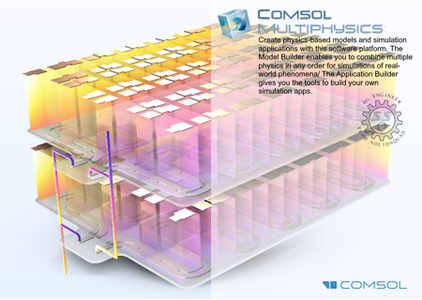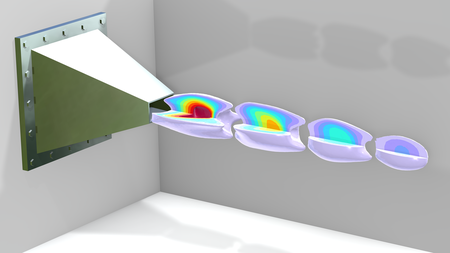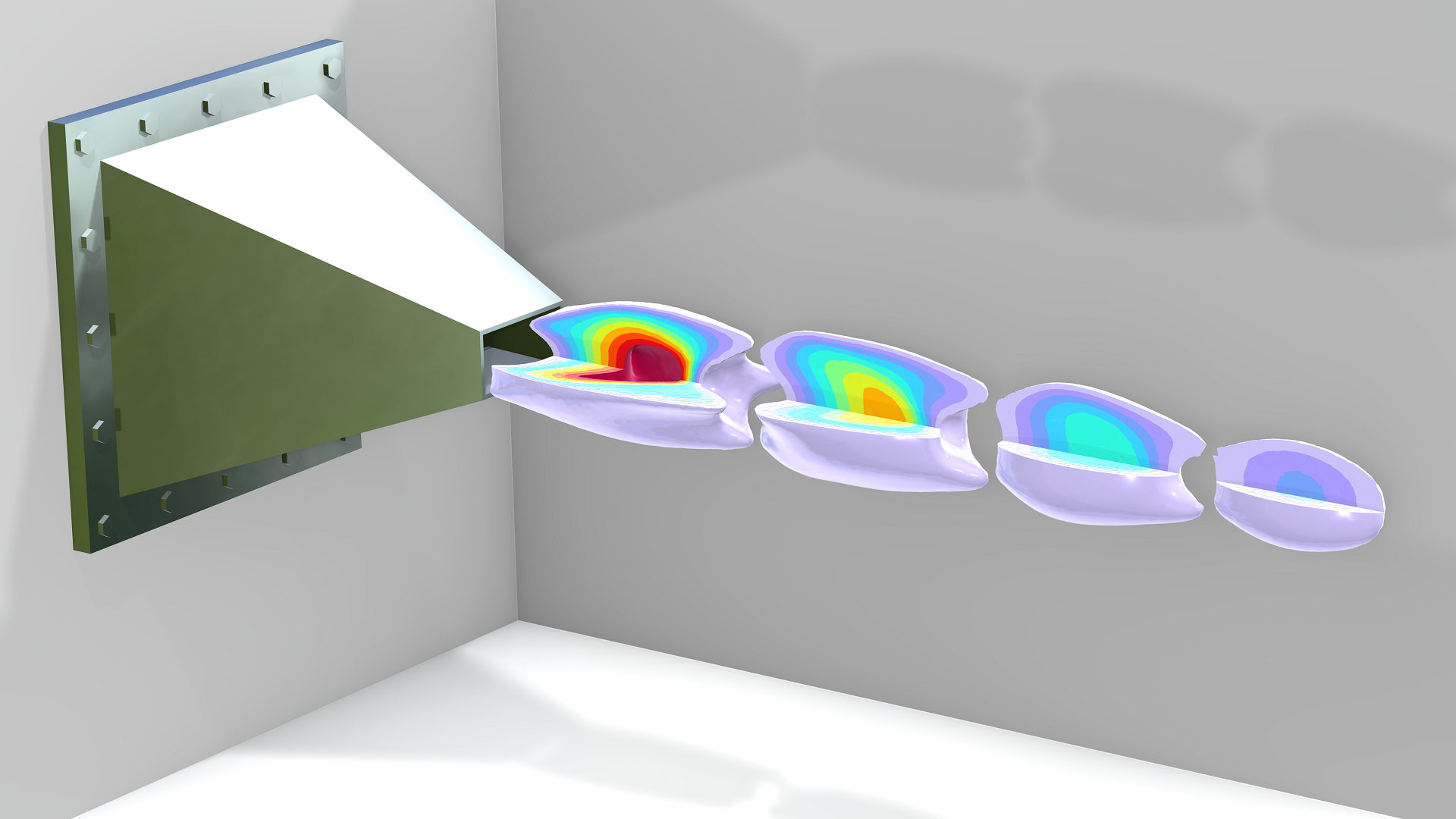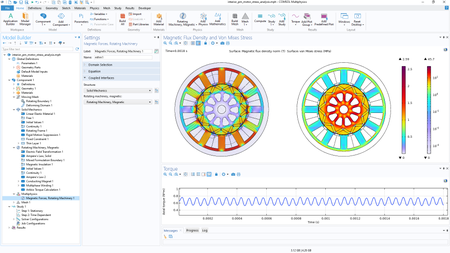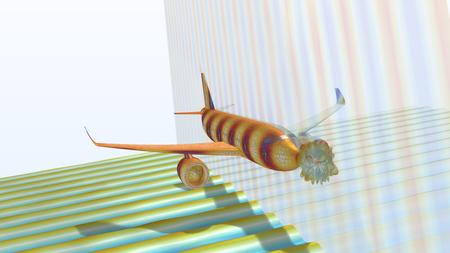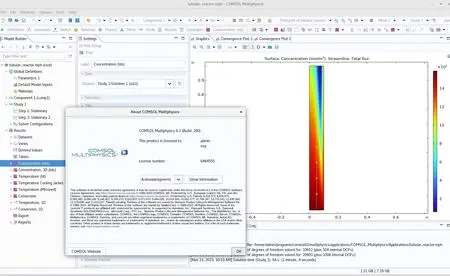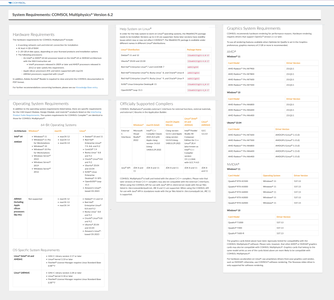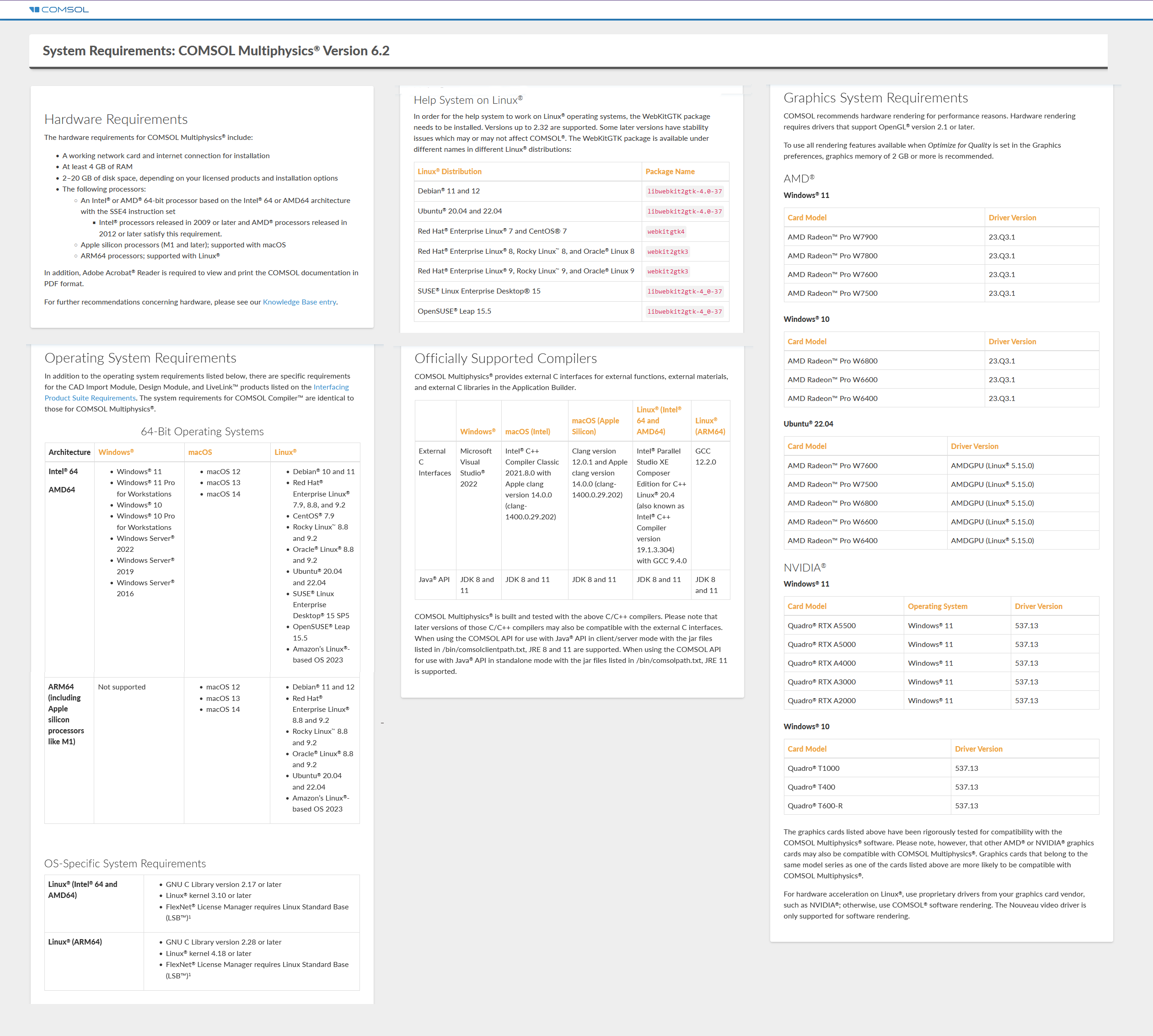Comsol Multiphysics 6.2 (290) | 23.4 Gb
Languages Supported: Simplified 中文, Traditional 中文, English,
Français, Deutsch, Italiano, 日本語, 한국어, Español.
Languages Supported: Simplified 中文, Traditional 中文, English,
Français, Deutsch, Italiano, 日本語, 한국어, Español.
COMSOL announced the release of COMSOL Multiphysics version 6.2, adding data-driven surrogate model functionality for efficient standalone simulation apps and multiphysics-based digital twins.
It also features high-performance multiphysics solvers for the analysis of electric motors, up to 40% faster turbulent CFD simulations, and an order of magnitude faster impulse response calculations for room and cabin acoustics. Additionally, it is now up to 7 times faster to perform boundary element analysis (BEM) for acoustics and electromagnetics when running on clusters.
Turbulent flow simulations are now up to 40% faster, showcased here by high-Mach-number flow through a ramjet nozzle.
Effective Simulation Apps and Digital Twins
Surrogate models deliver accurate simulation results much faster than the full-fledged finite element models that they approximate. When used in simulation apps, this leads to near-instantaneous results, providing app users with an improved interactive experience. In addition, surrogate models are useful for digital twins, where fast and frequent updates of simulation results are often necessary. The latest software version also introduces the ability to make simulation apps with automated updates through timer events, which is especially useful when creating digital twins or IoT-connected simulation apps.
High-Performance Multiphysics Simulations for Electric Motors
Version 6.2 expands the capabilities for efficient simulation of electric motors as well as for transformers and other electric machinery through a time periodic solver, available in the AC/DC Module. It also enables multiphysics motor analysis involving acoustics, structural mechanics, multibody dynamics, and heat transfer, and makes it possible to run optimization studies to find new motor designs.
Multiphysics analysis of an interior permanent magnet (IPM) motor combining electromagnetic and structural analysis.
Enhanced Modeling Capabilities Across the Product Suite
In version 6.2, users will discover new modeling features across the board. Core offerings, like visualization and meshing, are improved, and add-on products are expanded and updated. Version 6.2 also adds more than 100 new and updated example models, helping users enhance their modeling skills.
Some highlights from the broadened scope of physics modeling include:
- 7 turbulence models for high-Mach-number flow
- Realistic frequency-dependent materials for acoustics simulations in the time domain
- Modeling of hydrogen embrittlement in solids for fuel cells, electrolyzers, and corrosion
- Extended damage, fracture, and contact modeling
- Easy-to-use specific absorption computations for RF tissue simulations
- Analysis of light propagation through liquid crystals
- Ability to use local weather data for temperature and pressure in simulations, based on a GPS location
The boundary element method, used here for a radar cross section computation, is now up to 7 times faster.
COMSOL Multiphysics version 6.2 introduces game-changing functionality for simulation apps and digital twins as well as faster solver technology. Users can now increase the computational speed of their simulation apps using data-driven surrogate models, leading to a more interactive user experience and promoting wider use of simulations within an organization. Furthermore, the new surrogate model framework makes it possible to build new types of standalone simulation apps and effective digital twins.
Multiphysics simulations of electric machinery with nonlinear materials as well as impulse response simulations for acoustics are faster by an order of magnitude or more. CFD models now solve up to 40% faster. In chemical engineering applications, the new version includes functionality for the simulation of vapor–liquid interfaces, including both condensation and vaporization processes. Users of the structural-mechanics-based products will see updated damage and fracture modeling capabilities, along with functionality for circuit board warpage computation and multibody dynamics analysis of electric motors.
We have summarized the major news in the COMSOL software version 6.2 for you below:
General Updates
- Surrogate models for fast app execution
- Timer events for using apps as digital twins
- Add-ins for creating custom ribbon tabs with menus and buttons
- Visualization with floor shadows
- Streamline plots on curved surfaces
- Syntax highlighting for expressions
- Node filtering for the Model Builder tree
- Compare with Saved button for viewing all changes of a model since last saved
- General continuous tangent selections
- Improved search and maintenance operations for the Model Manager
- Application program interface (API) for Model Manager databases
- Uncertainty Quantification Module: correlated input parameters
- Optimization Module: eigenfrequency-based topology and shape optimization
Electromagnetics
- Faster nonlinear motor and transformer simulations with time-dimension periodicity
- New options for acoustic, structural, multibody, heat transfer, and optimization analysis of electric motors
- Dispersive material models for tissue and dielectrics
- Modeling of stranded conductors, such as litz wires
- Automatic stabilization of magnetic field simulations
- Enhanced high-frequency analysis based on the boundary element method (BEM)
- More efficient handling of chemical reactions in plasmas
- Preview of semiconductor doping profiles before solving
- New RF modeling options for averaging specific absorption rate (SAR) over 1-g and 10-g sample sizes
- Modeling of light wave propagation through liquid crystals
Structural Mechanics
- Phase field in solids for damage and fracture modeling
- Virtual crack extension method
- Automatic stabilization of contact models
- Warpage computation for circuit boards
- Magnetic–structure multiphysics analysis for electric motors
- Transport in solids for electromigration, hydrogen embrittlement, and other phenomena
- Strongly coupled moisture transport with structural deformations
- Inertia relief analysis for unconstrained structures accelerated by external loads
- New viscoplastic material model specialized for lithium in battery applications
- New material models for polymer viscoplasticity
- More powerful fiber modeling
- Multiple enhancements to shape memory alloys
- Specialized parameter estimation of experimental data for nonlinear materials
- New part library for unit cells and representative volume elements
- Piezoresistivity multiphysics with layered shells
Acoustics
- Order-of-magnitude faster impulse response calculations for room and cabin acoustics
- Realistic absorption modeling with frequency-dependent boundary impedance for time-domain analysis
- Anisotropic materials for poroelastic waves
- New port condition for aeroacoustics analysis of structures such as turbojet engine intakes
- Slip walls and surface tension for thermoviscous acoustics modeling
- Faster boundary element method (BEM) for acoustics
- Asymptotic waveform evaluation (AWE) method for dense frequency sweeps
- Modal analysis for vibroacoustic multiphysics
- Waveform Audio File Format (WAV) import
Fluid & Heat
- Up to 40% faster computations for turbulent flow
- 7 new RANS turbulence models for high-Mach-number flow
- Large eddy simulation (LES) for compressible flow
- Potential flow for initialization
- Mixing plane approach for rotating machinery
- Conformation formulation for viscoelastic flow
- ASHRAE weather data from GPS position
- Thermal resistance connection between distant surfaces
- Radiation in participating media for 2D axisymmetric models
- Increased performance and workflow for orbital thermal loads with heat radiation
- Nonisothermal reacting flow in porous media
- New option to couple Darcy's law flow in porous media with nonporous domains
- Parameter estimation functionality now included in the Polymer Flow Module
- Modeling of annealing in metal processing
Chemical & Electrochemical
- Gas–liquid equilibrium modeling for multiphase flows
- Contact resistance boundaries for electrochemistry and corrosion
- Pore-wall interaction (Knudsen diffusion) model for accurate gas diffusion electrode descriptions
- Automatic state-of-charge and state-of-health variable definitions for battery modeling
- Improved initial charge distribution for the initial state of charge, cell voltage, and electrode voltages
- Enhanced functionality for the modeling of impressed cathodic protection of pipelines
- Parameter estimation functionality now included in the Chemical Reaction Engineering Module
CAD and Mesh
- New distance measurement and centroid measurement features
- Detailed control of twisting along a sweep path
- Logical expressions for selections
- More broadly applicable swept mesh feature
- Easier generation of meshes for periodic boundaries
- New surface remeshing method for imported stereolithography (STL) meshes
- Improved edge selection for cap faces
- CAD import supports the most recent file versions
- Automatic handling of interior copper layer positions for ECAD import
- Improvement to the offset faces and loft functionality
Multiphysics simulations of electric machinery with nonlinear materials as well as impulse response simulations for acoustics are faster by an order of magnitude or more. CFD models now solve up to 40% faster. In chemical engineering applications, the new version includes functionality for the simulation of vapor–liquid interfaces, including both condensation and vaporization processes. Users of the structural-mechanics-based products will see updated damage and fracture modeling capabilities, along with functionality for circuit board warpage computation and multibody dynamics analysis of electric motors.
We have summarized the major news in the COMSOL software version 6.2 for you below:
General Updates
- Surrogate models for fast app execution
- Timer events for using apps as digital twins
- Add-ins for creating custom ribbon tabs with menus and buttons
- Visualization with floor shadows
- Streamline plots on curved surfaces
- Syntax highlighting for expressions
- Node filtering for the Model Builder tree
- Compare with Saved button for viewing all changes of a model since last saved
- General continuous tangent selections
- Improved search and maintenance operations for the Model Manager
- Application program interface (API) for Model Manager databases
- Uncertainty Quantification Module: correlated input parameters
- Optimization Module: eigenfrequency-based topology and shape optimization
Electromagnetics
- Faster nonlinear motor and transformer simulations with time-dimension periodicity
- New options for acoustic, structural, multibody, heat transfer, and optimization analysis of electric motors
- Dispersive material models for tissue and dielectrics
- Modeling of stranded conductors, such as litz wires
- Automatic stabilization of magnetic field simulations
- Enhanced high-frequency analysis based on the boundary element method (BEM)
- More efficient handling of chemical reactions in plasmas
- Preview of semiconductor doping profiles before solving
- New RF modeling options for averaging specific absorption rate (SAR) over 1-g and 10-g sample sizes
- Modeling of light wave propagation through liquid crystals
Structural Mechanics
- Phase field in solids for damage and fracture modeling
- Virtual crack extension method
- Automatic stabilization of contact models
- Warpage computation for circuit boards
- Magnetic–structure multiphysics analysis for electric motors
- Transport in solids for electromigration, hydrogen embrittlement, and other phenomena
- Strongly coupled moisture transport with structural deformations
- Inertia relief analysis for unconstrained structures accelerated by external loads
- New viscoplastic material model specialized for lithium in battery applications
- New material models for polymer viscoplasticity
- More powerful fiber modeling
- Multiple enhancements to shape memory alloys
- Specialized parameter estimation of experimental data for nonlinear materials
- New part library for unit cells and representative volume elements
- Piezoresistivity multiphysics with layered shells
Acoustics
- Order-of-magnitude faster impulse response calculations for room and cabin acoustics
- Realistic absorption modeling with frequency-dependent boundary impedance for time-domain analysis
- Anisotropic materials for poroelastic waves
- New port condition for aeroacoustics analysis of structures such as turbojet engine intakes
- Slip walls and surface tension for thermoviscous acoustics modeling
- Faster boundary element method (BEM) for acoustics
- Asymptotic waveform evaluation (AWE) method for dense frequency sweeps
- Modal analysis for vibroacoustic multiphysics
- Waveform Audio File Format (WAV) import
Fluid & Heat
- Up to 40% faster computations for turbulent flow
- 7 new RANS turbulence models for high-Mach-number flow
- Large eddy simulation (LES) for compressible flow
- Potential flow for initialization
- Mixing plane approach for rotating machinery
- Conformation formulation for viscoelastic flow
- ASHRAE weather data from GPS position
- Thermal resistance connection between distant surfaces
- Radiation in participating media for 2D axisymmetric models
- Increased performance and workflow for orbital thermal loads with heat radiation
- Nonisothermal reacting flow in porous media
- New option to couple Darcy's law flow in porous media with nonporous domains
- Parameter estimation functionality now included in the Polymer Flow Module
- Modeling of annealing in metal processing
Chemical & Electrochemical
- Gas–liquid equilibrium modeling for multiphase flows
- Contact resistance boundaries for electrochemistry and corrosion
- Pore-wall interaction (Knudsen diffusion) model for accurate gas diffusion electrode descriptions
- Automatic state-of-charge and state-of-health variable definitions for battery modeling
- Improved initial charge distribution for the initial state of charge, cell voltage, and electrode voltages
- Enhanced functionality for the modeling of impressed cathodic protection of pipelines
- Parameter estimation functionality now included in the Chemical Reaction Engineering Module
CAD and Mesh
- New distance measurement and centroid measurement features
- Detailed control of twisting along a sweep path
- Logical expressions for selections
- More broadly applicable swept mesh feature
- Easier generation of meshes for periodic boundaries
- New surface remeshing method for imported stereolithography (STL) meshes
- Improved edge selection for cap faces
- CAD import supports the most recent file versions
- Automatic handling of interior copper layer positions for ECAD import
- Improvement to the offset faces and loft functionality
COMSOL Multiphysics is a general-purpose simulation software used in all fields of engineering, manufacturing, and scientific research. The software brings fully coupled multiphysics and single-physics modeling capabilities, model management, and user-friendly tools for building simulation applications. Spread the value of simulation to your design teams, manufacturing departments, test labs, customers, and other collaborators by distributing your apps using COMSOL Compiler and COMSOL Server. Add-on modules provide specialized functionality for electromagnetics, structural mechanics, acoustics, fluid flow, heat transfer, and chemical engineering. Interfacing products are available for CAD and other third-party software. All add-on products from the product suite connect seamlessly with COMSOL Multiphysics for a modeling workflow that remains the same regardless of what you are modeling.
COMSOL Multiphysics Version 6.2
The latest version of COMSOL Multiphysics solidifies its standing as a comprehensive multiphysics simulation software, offering unmatched physics modeling and simulation capabilities within a single software environment. It also enhances its support for building, maintaining, and compiling standalone simulation apps, thereby extending the use of simulation to individuals beyond the modeling and simulation community.
Svante Littmarck and Farhad Saeidi founded COMSOL AB in 1986 in Stockholm, Sweden. Since then, the company has grown into a group of subsidiaries spread around the world. Today, Svante Littmarck is the CEO of the COMSOL Group and the president and CEO of COMSOL, Inc. Farhad Saeidi is the president of COMSOL AB. The group flagship product, COMSOL Multiphysics, is used in all fields of engineering, manufacturing, and scientific research for modeling multiphysics systems. Our customers use the software to understand, predict, innovate, and optimize product designs and processes.
Owner: COMSOL AB
Product Name: Comsol Multiphysics
Version: 6.2.0.290, November 16, 2023 *
Supported Architectures: x64
Website Home Page : www.comsol.com
Languages Supported: multilanguage
System Requirements: Windows, Linux, macOs(Intel), macOs(arm64) **
Size: 23.4 Gb
COMSOL62_full_macarm64_Apple silicon.dmg
COMSOL62_full_maci64_ macOS Intel.dmg
COMSOL62_dvd_Windows_Linux.iso
COMSOL62_full_maci64_ macOS Intel.dmg
COMSOL62_dvd_Windows_Linux.iso
Please visit my blog
Added by 3% of the overall size of the archive of information for the restoration
No mirrors please
Added by 3% of the overall size of the archive of information for the restoration
No mirrors please


